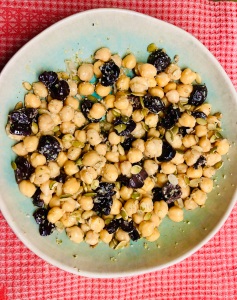You might be wondering where the hamantaschen recipe is (scroll to the bottom) or why I’m sharing a bean recipe for Purim. The Queen Esther salad that I created is for a Purim seudah (meal) and is made with many symbolic ingredients. First, according to Gil Marks in Olives and Honey Trees, chickpeas are a traditional Ashkenazi food eaten at Purim (amongst other celebrations). Olives are a symbol of mourning and also commonly eaten in Purim dishes that symbolized Haman (along with eggs and other ingredients like noodles), as explained in Claudia Roden’s, The Book of Jewish Food. Last, there’s a Talmudic teaching that Queen Esther became a vegan, eating just legumes and seeds while she lived in King Achashaverus palace, to ensure she did not eat non kosher foods (another bonus of being vegan :)). I generally sprinkle seeds on my salad, because I like the crunchy texture and contrasting flavors they provide. And, if you’re looking for more delicious (and sweet) Purim recipes, they are at the bottom of the post (including two types of hamantaschen)!
Ingredients
- 1 can chickpeas, rinsed and drained.
- 3 tbsp black olives, pits removed
- 1 tbsp hemp seeds
- 1 tbsp sunflower seeds
- 2 tbsp pepitas
- 1/2 lemon juice
- 1 tbsp olive oil
- salt to taste
Preparation
- Rinse and dry chickpeas. Add to a bowl.
- Add olives, seeds and mix. Drizzle olive oil, lemon juice and salt. Mix again.
B’tayavon!
More Vegan Purim Recipes
Ma’amoul Cookies
Orange, Tahini, Olive Oil Cake
Hamantaschen
Tahini Hamantaschen
Chocolate Truffles
Stuffed Dates


